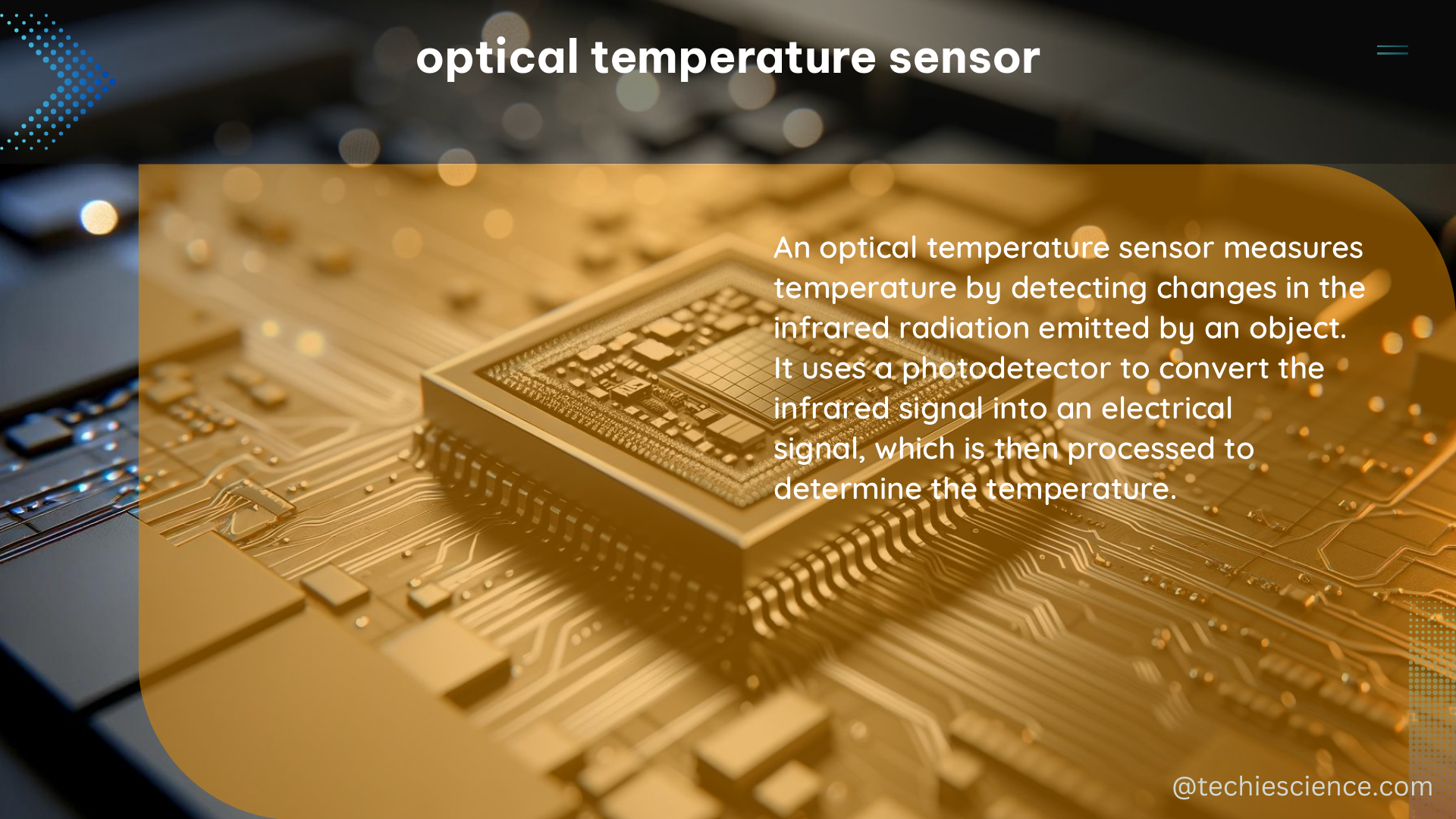Optical temperature sensors are widely used for precise temperature measurements in various industrial, infrastructure, and environmental applications. These sensors leverage the principles of optics to provide accurate, reliable, and versatile temperature monitoring solutions that overcome the limitations of traditional electronic sensors.
Understanding Optical Temperature Sensors
Optical temperature sensors operate on different principles, with the most common being fiber optic-based sensors and infrared (IR) sensors. Fiber optic sensors can be further categorized into point sensors and distributed sensing systems.
Fiber Optic Temperature Sensors
Point Sensors:
– Measure temperature at a specific location along the optical fiber
– Utilize various techniques, such as Fiber Bragg Gratings (FBGs), Fabry-Pérot interferometers, and fluorescence-based sensors
– Offer high accuracy, typically within ±0.1°C to ±1°C, depending on the sensor type
– Suitable for applications where precise temperature monitoring at a specific point is required
Distributed Sensing Systems:
– Measure temperature along the entire length of an optical fiber
– Rely on principles like Raman scattering, Brillouin scattering, or Rayleigh scattering
– Provide spatial temperature profiles with a resolution of 0.1°C to 1°C
– Sensing ranges can extend up to several kilometers
– Ideal for monitoring temperature in long structures, such as pipelines, power transmission lines, and civil infrastructure
Infrared Temperature Sensors
- Measure the intensity of thermal radiation emitted by objects
- Can be used for both point measurements and imaging applications
- Suitable for industrial process control, building automation, and fire detection
- Offer a wide temperature range, typically from -40°C to 2000°C
- Accuracy can range from ±1°C to ±0.1°C, depending on the sensor type and application
Key Specifications and Considerations

When selecting an optical temperature sensor, several technical specifications and factors should be considered:
-
Temperature Range: Ensure the sensor can operate within the required temperature range for the application, which can vary from cryogenic temperatures to high-temperature environments.
-
Measurement Accuracy: Determine the required level of temperature measurement accuracy, which can range from ±0.1°C to ±5°C, depending on the sensor type and application.
-
Response Time: Understand the sensor’s response time, which can vary from milliseconds to seconds, depending on the sensor design and application requirements.
-
Spatial Resolution: For distributed sensing systems, consider the spatial resolution, which determines the distance between individual temperature measurements along the optical fiber.
-
Sensing Range: For distributed sensing systems, the sensing range can extend up to several kilometers, making them suitable for long-distance temperature monitoring applications.
-
Environmental Factors: Evaluate the sensor’s resistance to electromagnetic interference, chemical exposure, and other environmental conditions that may impact its performance.
-
Power Requirements: Determine the power requirements of the sensor, especially for remote or inaccessible applications where power supply may be limited.
-
Compatibility and Integration: Ensure the optical temperature sensor is compatible with the existing infrastructure and can be easily integrated into the overall system.
Applications of Optical Temperature Sensors
Optical temperature sensors find applications in a wide range of industries and sectors, including:
- Industrial Process Control: Monitoring temperatures in manufacturing processes, furnaces, reactors, and other industrial equipment.
- Infrastructure Monitoring: Measuring temperatures in bridges, tunnels, dams, and other civil structures to detect potential issues.
- Energy and Utilities: Monitoring temperatures in power transmission lines, oil and gas pipelines, and renewable energy systems.
- Building Automation: Controlling HVAC systems, fire detection, and energy management in commercial and residential buildings.
- Aerospace and Defense: Measuring temperatures in aircraft, spacecraft, and military equipment.
- Research and Development: Enabling precise temperature measurements in scientific experiments and laboratory settings.
Advantages of Optical Temperature Sensors
Optical temperature sensors offer several advantages over traditional electronic sensors:
- Wide Temperature Range: Capable of operating in extreme temperature environments, from cryogenic to high-temperature conditions.
- Electromagnetic Immunity: Insensitive to electromagnetic interference, making them suitable for use in high-voltage or electrically noisy environments.
- Electrical Isolation: Eliminate the need for electrical cables, which is crucial for high-voltage applications where insulating materials are required.
- Distributed Sensing Capabilities: Distributed sensing systems can provide continuous temperature monitoring along the entire length of an optical fiber.
- Improved Safety: Optical sensors do not generate sparks or heat, reducing the risk of ignition in hazardous environments.
- Compact and Lightweight: Optical sensors can be designed to be small and lightweight, making them suitable for a wide range of applications.
Conclusion
Optical temperature sensors offer a versatile and advanced solution for precise temperature measurement in a wide range of industrial, infrastructure, and environmental applications. By understanding the different operating principles, key specifications, and the advantages of these sensors, users can select the most appropriate optical temperature sensor to meet their specific requirements.
References:
– J. P. Dakin et al., “Distributed optical fiber Raman temperature sensor using a semiconductor light source and detector”, Electron. Lett. 21 (13), 569 (1985); https://doi.org/10.1049/el:19850402
– A. H. Hartog et al., “Distributed temperature sensing in solid-core fibres”, Electron. Lett. 21 (23), 1061 (1985); https://doi.org/10.1049/el:19850752
– RP Photonics, “Optical Temperature Sensors”, RP Photonics (2023); https://www.rp-photonics.com/optical_temperature_sensors.html
– Fiber Optic Sensors: An Introduction for Engineers and Scientists, Eric Udd and William B. Spillman Jr., Wiley, 2011.
– Optical Fiber Sensors: Advanced Techniques and Applications, Edited by Shizhuo Yin, Paul B. Ruffin, and Francis T.S. Yu, CRC Press, 2008.

The lambdageeks.com Core SME Team is a group of experienced subject matter experts from diverse scientific and technical fields including Physics, Chemistry, Technology,Electronics & Electrical Engineering, Automotive, Mechanical Engineering. Our team collaborates to create high-quality, well-researched articles on a wide range of science and technology topics for the lambdageeks.com website.
All Our Senior SME are having more than 7 Years of experience in the respective fields . They are either Working Industry Professionals or assocaited With different Universities. Refer Our Authors Page to get to know About our Core SMEs.